AUDI A7 2018 Owners Manual
Manufacturer: AUDI, Model Year: 2018, Model line: A7, Model: AUDI A7 2018Pages: 274, PDF Size: 42.77 MB
Page 141 of 274
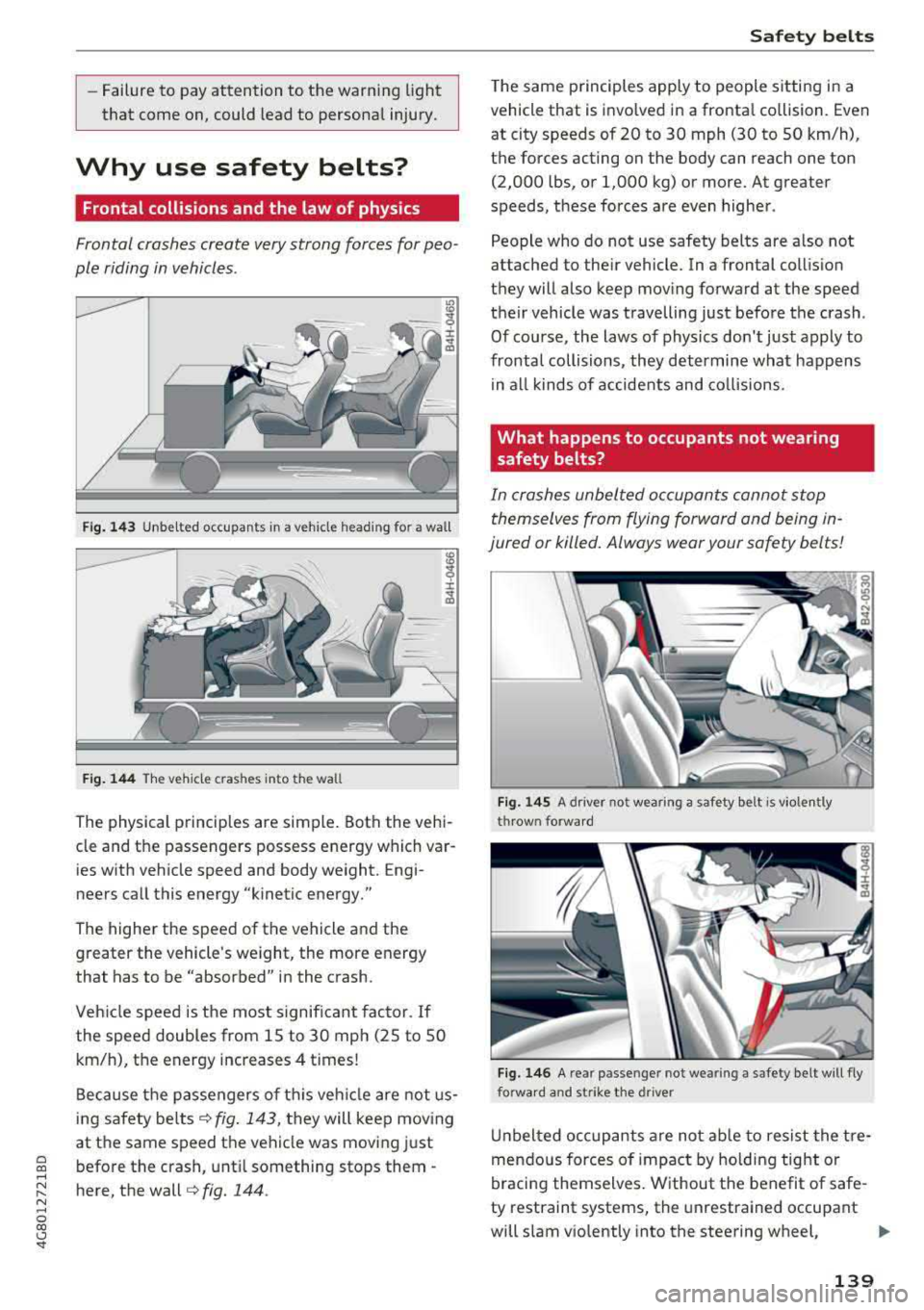
a co ,...,
N
" N ,...,
0 00 <.,;) '
that come on, could lead to personal injury.
Why use safety belts?
Frontal collisions and the law of physics
Frontal crashes create very strong forces for peo
ple riding in vehicles .
Fig. 143 Unbelted occupants in a vehicle heading for a wall
Fig. 144 The vehicle crashes into the wall
The physical principles are simple. Both the vehi
cle and the passengers possess energy which var ies with vehicle speed and body weight. Engi
neers ca ll this energy "k inetic energy."
The higher the speed of the vehicle and the greater the vehicle's we ight, the more energy
that has to be "absorbed" in the crash.
Veh icle speed is the most significant factor. If
the speed doubles from 15 to 30 mph (25 to 50
km/h), the energy increases 4 t imes!
Because the passengers of this vehicle are not us
ing safety belts¢
fig. 143, they will keep moving
at the same speed the vehicle was moving just
before the crash, until something stops them -
here, the wall¢
fig. 144.
Safety belts
T he same p rinciples apply to people s itting in a
vehicle that is invo lved in a fronta l co llision. Even
at city speeds of 20 to 30 mph (30 to SO km/h),
the forces acting on the body can reach one ton
(2,000 lbs, or 1,000 kg) or more. At greater
speeds, these forces are even higher.
People who do not use safety belts are a lso not
attached to the ir vehicle. In a frontal collis ion
they will also keep moving forward at the speed
their vehicle was travelling just before the crash .
Of course, the laws of physics don't just apply to
frontal collisions, they determine what happens in all kinds of accidents and collisions .
What happens to occupants not wea ring
safety belts?
In crashes unbelted occupants cannot stop
themselves from flying forward and being in
jured or killed. Always wear your safety belts!
Fig. 14S A driver not wearing a safety belt is violently
thrown forward
Fig . 146 A rear passe nger not wearing a safety belt will fly
forwa rd and strike the driver
Unbelted occupants are not able to resist the tre
mendous forces of impact by holding tight or
bracing themselves . Without the benefit of safe
ty restraint systems, the unrestrained occupant
will slam violently into the steering wheel,
IJI,,-
139
Page 142 of 274
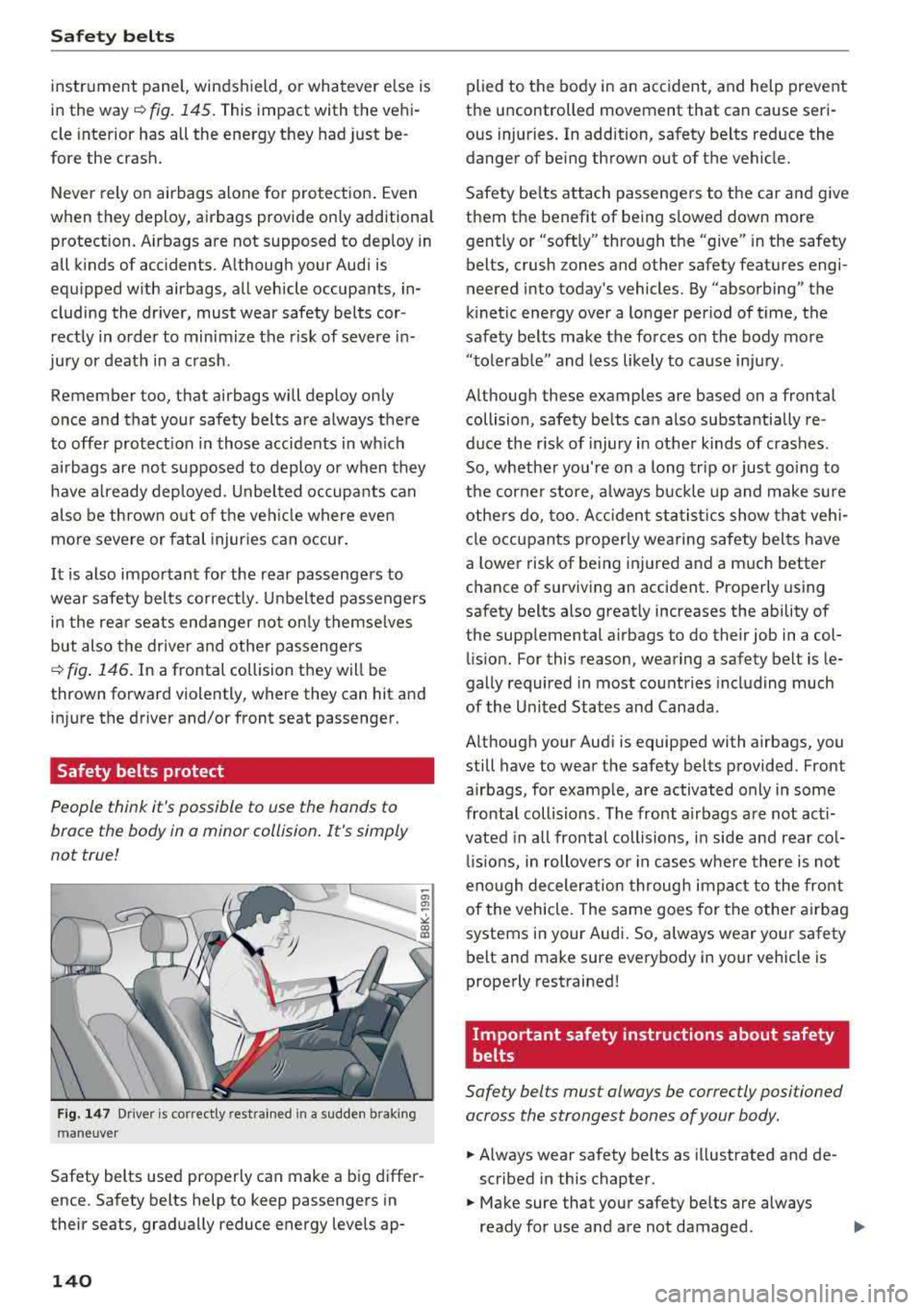
Safe ty belts
instrument panel, windshield, or whatever e lse is
in the way
r:!> fig. 145. This impact with the vehi
cle interior has all the energy they had just be
fore the crash.
Never rely on airbags alone for protection . Even
when they deploy, airbags provide only additiona l
protection. A irbags are not supposed to dep loy in
all kinds of accidents. A lthough your Audi is
equipped w ith airbags, all vehicle occupants, in
cluding the dr iver, must wear safety belts cor
rectly in order to minimize the risk of severe in
jury or death in a crash .
Remember too, that airbags will deploy only
once and that your safety belts are always there
to offer protect ion in those accidents in w hich
airbags are not supposed to deploy or when they
have a lready deployed . Unbel ted occupants can
a lso be thrown o ut of the veh icle where eve n
mo re severe or fatal injur ies can occur .
It is also important for the rear passenge rs to
wear safety belts correctly. Unbel ted passengers
i n t he re ar seats endanger no t on ly themse lves
but also the drive r and other passengers
c::> fig . 146 . In a frontal collision they will be
thrown forward violently, where they can hit and
in jure the driver and/or front seat passenger .
Safety belts protect
People think it's possible to use the hands to
brace the body in a minor collision . It's simply
not true!
F ig . 14 7 Driver is co rrectly restrai ned in a sudde n brak ing
m aneu ver
Safety belts used properly can make a b ig d iffer
ence. Safety belts help to keep passengers in
their seats, gradually reduce energy levels ap-
140
plied to the body in an accident, and help prevent
the uncontrolled movement that can cause seri
ous injuries. In addition, sa fety belts reduce the
danger of being thrown out of the vehicle.
Safety be lts attach passengers to the car and give
them the benefit of being s lowed down more
gently or "soft ly" through the "give" in the safety
belts, crush zones and other safety features engi
neered into today's vehicles. By "absorbing" the
k inet ic energy over a longer per iod of t ime, the
safety belts make the forces on the body more "tole rab le" and less likely to cause inju ry .
Although these examples are based on a frontal
collision, safety be lts ca n also substantially re
duce the r isk o f injury in ot her kinds of crashes .
So, whethe r you're on a long trip or just going to
the cor ne r store, a lways b uckle up and make s ure
othe rs do, too. Ac ciden t st at istic s show that veh i
cl e occupants prope rly wearing safety bel ts have
a lowe r risk of be ing injured and a m uch better
chance of surviving an acc ident . Properly using
safety be lts also great ly increases the ability of
the supp lemental airbags to do their job in a col
li sion. For this reason , wearing a safety belt is le
gally required in most countries including much
of the United States and Canada.
Although your Aud i is equipped with airbags, you
still have to wear the safety belts provided. Front
airbags, for examp le, are activated only in some
frontal collisions. The front airbags are not act i
vated in a ll frontal collisions, in side and rear co l
li sio ns, in rollovers or in cases whe re there is not
eno ugh decelerat ion throug h impa ct to the front
of the vehicle . The same goes for the other a irbag
systems in your Audi. So, always wear your safety
belt and make sure everybody in your vehicle is
properly rest rained!
Important safety instructions about safety
belts
Safety belts must always be correctly positioned
across the strongest bones of your body .
.,. Always wear safety belts as illustrated and de
scribed in this chapter.
.,. Make sure that your safety be lts are always
ready for use a nd a re not damaged .
Page 143 of 274
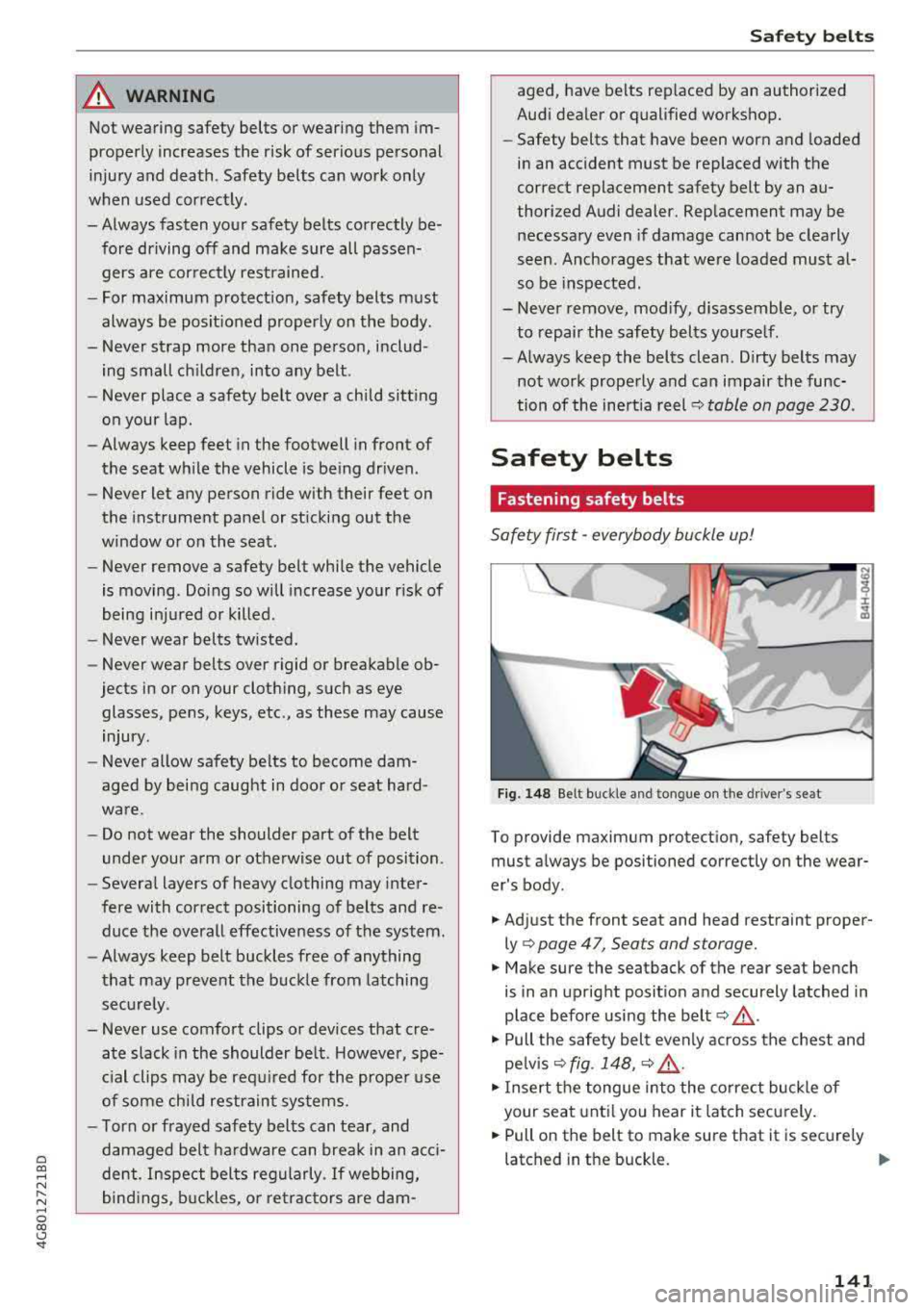
a co ,...,
N
" N ,...,
0 00 <.,;) '
Not wearing safety belts or wearing them im
properly increases the risk of serious personal
injury and death . Safety belts can work only
when used correctly.
-Always fasten your safety belts correctly be fore driving off and make sure all passen
gers are cor rectly restrained.
-For maximum protection, safety belts must
always be posit ioned properly on the body .
-Never strap more than one person, includ
ing small ch ildren, into any belt .
-Never place a safety belt over a child sitt ing
on your lap.
- Always keep feet in the footwell in front of
the seat wh ile the vehicle is being driven.
- Never let any person ride w ith their feet on
the instrument panel or st icki ng out the
window or on the seat.
- Never remove a safety belt while the vehicle
is moving . Do ing so will increase your risk of
being injured or k illed.
- Never wear belts twisted.
- Never wear belts over rigid or breakable ob-
jects in or on your clothing, such as eye
glasses, pens, keys, etc ., as these may cause
injury.
- Never allow safety belts to become dam
aged by being caught in door or seat hard
ware.
- Do not wear the shoulder part of the belt
under your arm or otherwise out of position .
- Several layers of heavy clothing may inter
fere with correct positioning of belts and re
duce the overall effectiveness of the system.
- Always keep belt buckles free of anything
that may prevent the buckle from latching
securely .
-Never use comfort clips or devices that cre
ate slack in the shoulder be lt . However, spe
c ial clips may be requ ired for the proper use
of some child restraint systems.
-Torn or frayed safety belts can tear, and
damaged belt hardware can break in an acc i
dent. Inspect belts regularly .
If webbing,
bind ings, buckles, or retractors are dam-
Safety bel ts
aged, have belts rep laced by an authorized
Aud i dea ler or qualified workshop.
- Safety belts that have been worn and loaded
in an accident must be replaced with the
correct replacement safety belt by an au
thor ized Audi dealer. Replacement may be
necessary even if damage cannot be clearly
seen. Anchorages that were loaded must al
so be inspected.
- Never remove, mod ify, d isassemble, or try
to repair the safety belts yourse lf.
-Always keep the belts clean . Dirty belts may
not work properly and can impair the func
tion of the inert ia reel
q table on page 230 .
Safety belts
Fastening safety belts
Safety first -everybody buckle up!
Fig. 148 Be lt buckle and to ngue on t he d river' s se at
To provide maximum protection, safety belts
must always be positioned correctly on the wear
er 's body .
.. Adjust the front seat and head restra int proper
ly
q page 47, Sea ts and storage.
.. Make sure the seatback of the rear seat bench
is in an upright posit ion and securely latched in
p lace before using the belt
q ,&. .
.. Pull the safety belt evenly across the chest and
pe lvis
q fig . 148, q ,&. .
.. Insert the tongue in to the correct buckle of
your seat until you hear it latch securely.
.. Pull on the belt to make sure that it is securely
latched in the buckle.
..,
141
Page 144 of 274
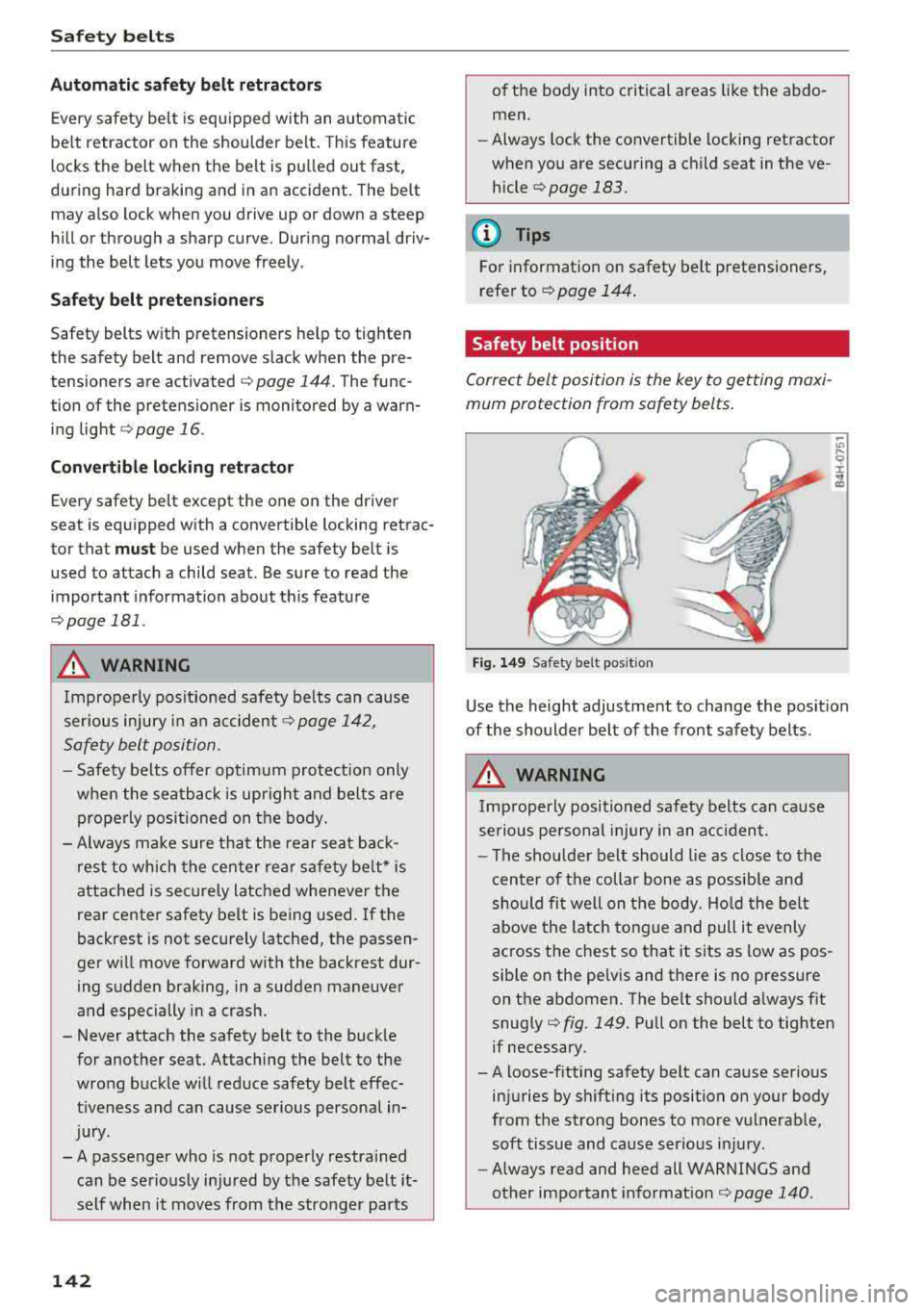
Safe ty belts
Autom ati c s afet y belt retractors
Every safety be lt is equ ipped with an automatic
be lt retractor on the shoulder belt. This feature
locks the belt when the belt is pu lled out fast,
during hard braking and in an accident. The belt may a lso lock when you drive up or down a steep
hill or through a sharp curve. Dur ing normal driv
ing the belt lets you move freely.
Safety belt p ret en sione rs
Safety belts w ith pretensioners he lp to tighten
the safety belt and remove s lack when the pre
tensioners are activated
c;, page 144 . The func
tion of the pretensioner is monitored by a warn
ing light
c;, page 16 .
Convertibl e loc king r etracto r
Every safety belt except the one on the driver
seat is equipped w ith a convertible locking retrac
tor that
must be used when the safety belt is
used to attach a child seat. Be sure to read the
important information about this feature
¢ page 181 .
.&_ WARNING
Improperly pos itioned safety be lts can cause
ser ious injury in an
accident ¢ page 142,
Safety belt position.
- Safety belts offer optimum protection only
when the seatback is upright and belts are
properly positioned on the body.
- Always make sure that the rear seat bac k
rest to which the center rea r safety belt* is
attached is securely latched whenever the
rear center safety belt is being used. If the
backrest is not securely latched, the passen
ger will move forward with the backrest dur
ing sudden braking, in a sudden maneuver
and especially in a crash.
- Never attach the safety belt to the buckle for another seat. Attaching the belt to the
wrong b uckle wi ll reduce safety belt effec
t iveness and can cause serious person-a l in
jury.
- A passenger who is not properly restrained can be seriously in jured by the safety be lt it
self when it
moves from the stronger parts
142
of the body into critical areas like the abdo men.
- Always lock the convertible locking retractor
when you are securing a child seat in the ve
hicle
,=;, page 183.
(D Tips
For information on safety belt pretensioners,
refer to
c;, page 144 .
Safety belt position
Correct belt position is the key to getting maxi
mum protection from safety belts .
Fig. 149 Safety belt posit ion
Use the height adjustment to change the posit ion
of the shoulder belt of the front safety belts .
.&_ WARNING
Imp roperly positioned safety belts can cause
serio us pe rsonal injury in an a cc ident.
- The shou lde r belt should lie as close to the
center of the collar bone as possib le and
should fi t well on the body. Ho ld the belt
above the latch to ngue and pull it evenly
across the chest so that it sits as low as pos
sible on the pe lvis and there is no pressure
on the abdomen. The belt should a lways f it
snug ly
c;, fig. 149. Pull on the belt to tighten
if necessary.
- A loose-fitting safety belt can cause serious
injuries by sh ifting its position on your body
from the strong bones to more vulnerable,
soft tissue and cause serious i nju ry .
- Always read and heed all WARNINGS and
other important informat ion
c;, page 140 .
Page 145 of 274
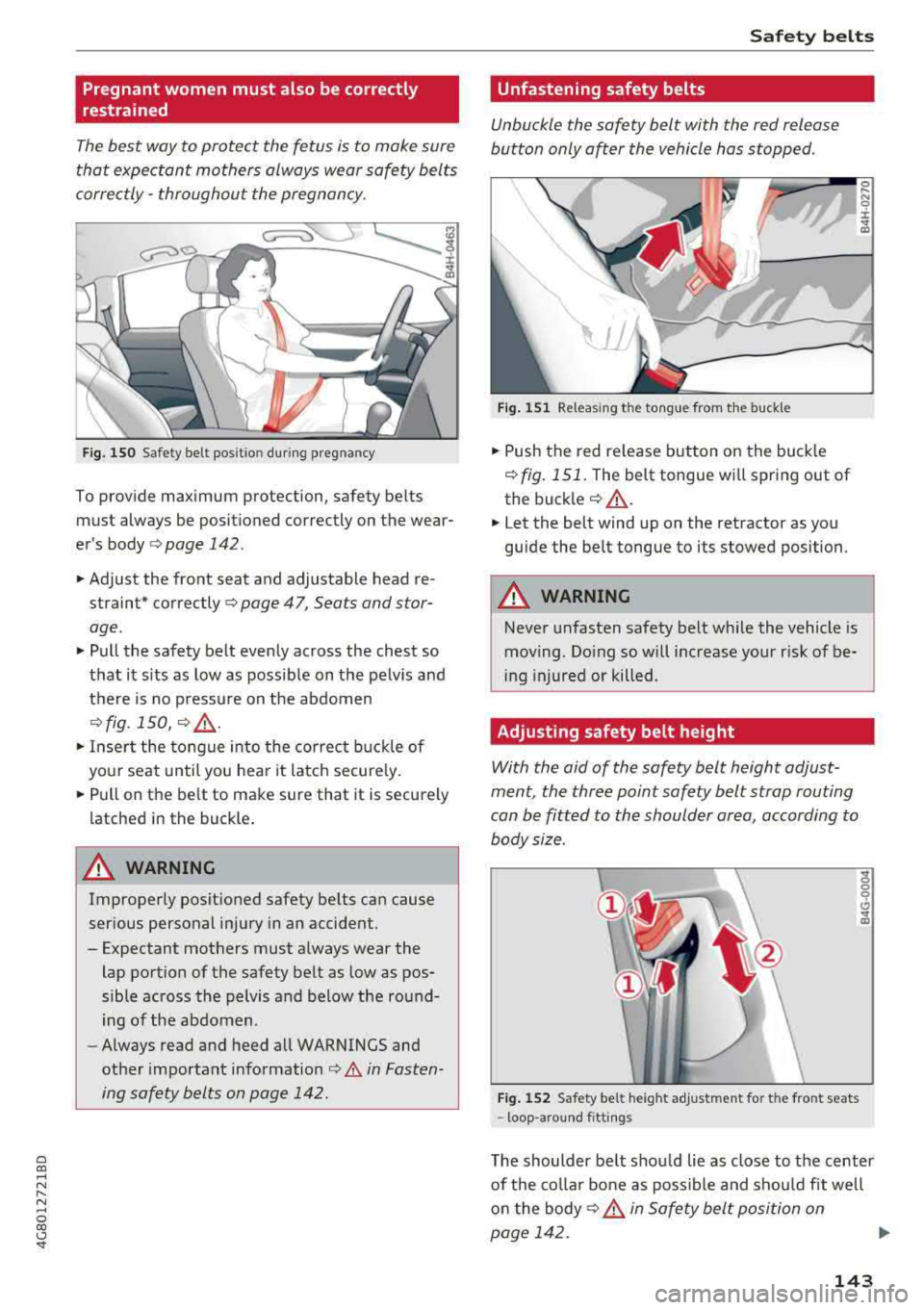
a co ,...,
N
" N ,...,
0 00 <..:l '
restrained
The best way to protect the fetus is to make sure
that expectant mothers always wear safety belts
correctly
-throughout the pregnan cy.
F ig. 150 Safety belt pos itio n during pregnancy
To prov ide max imum protection, safety belts
must always be posit ioned correctly on the wear
er 's body
r=> poge 142.
.,. Adjust the front seat and adjustable head re
straint* correctly ¢
page 47, Seats and stor
age .
.,. Pull the safety belt evenly across the chest so
that it sits as low as poss ib le on the pelv is and
there is no pressure on the ab domen
¢fig. 150, ¢ .(D..
.,. Inse rt the tongue into the cor rec t buckle of
your seat until you hea r it latch secure ly .
.. Pull on the be lt to make sure that it is securely
latched in the buck le .
A WARNING
Improperly posit ioned safety be lts can cause
ser ious personal injury in an accident.
- Expectant mothers must always wear the lap portion of the safety belt as low as pos
sible across the pelvis and below the round
ing of the abdomen.
- Always read a nd heed all WARN INGS and
other important information
c:> .&. in Fasten
ing safety belts on page 142.
Safet y bel ts
Unfastening safety belts
Unbuckle the safety belt with the red release
button only
o~er the vehicle hos stopped.
F ig . 1 51 Releasing th e to ngue from the buckle
.. Push the red re lease button on the buck le
r=> fig . 151. The belt tongue w ill spring out of
the
buck ler=> .(D. .
.. Let the belt wind up on the retractor as you
guide the belt tongue to its stowed position .
A WARNING
Never unfasten safety belt wh ile the vehicle is
moving . Do ing so will increase your r isk of be
i ng injured or killed .
Adjusting safety belt height
With the aid of the safety belt height adjust
ment, the three point safety belt strop routing
con be fitted to the shoulder area, according to
body size.
Fi g. 1 52 Safety belt height adj ust m ent fo r th e fro nt seats
-loop -arou nd fitt ings
0 ..... N 0 :i:
of the co ll ar bo ne as possible and shou ld fit well
o n the body
c:> LD. in Safe ty belt position on
page 142.
..,.
143
Page 146 of 274
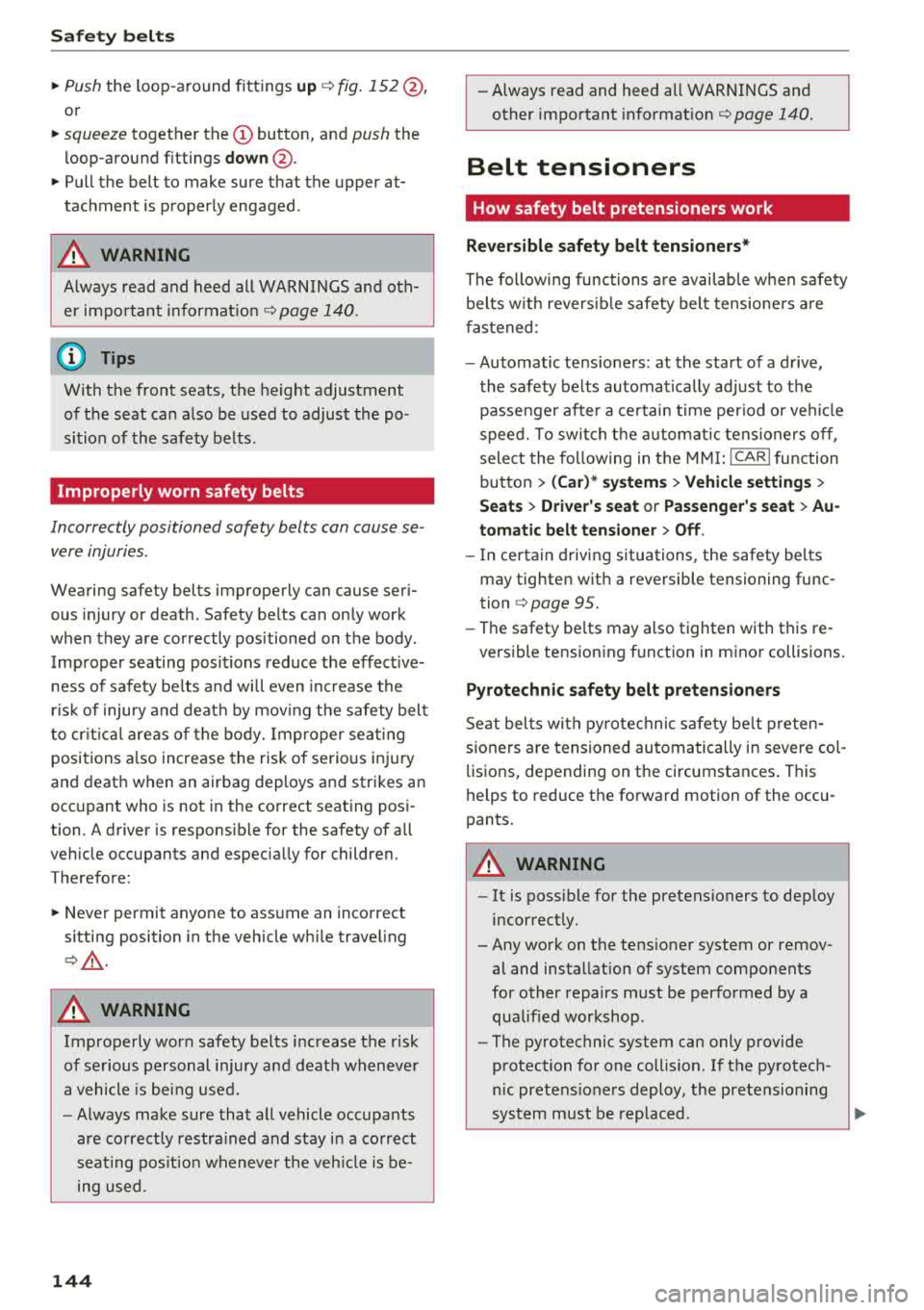
Safe ty belt s
~ Push the loop -around fittings up ¢ fig. 152 @,
or
~ squeeze together the (D button, and push the
loop-around fittings
do wn@ .
~ Pull the belt to make sure that the upper at
tachment is properly engaged .
A WARNING
Always read and heed all WARNINGS and oth
er impo rtant informat io n
¢page 140.
(D Tips
With the front seats, the height adjustment
of the seat can also be used to adjust the po
sition of the safety belts .
Improperly worn safety belts
Incorrectly positioned safety belts can cause se
vere injuries .
Wearing safety belts improperly can cause seri
ous injury or death. Safety belts can only work
when they are correctly pos itioned on the body .
Imp roper seating posit ions reduce the effect ive
ness of safety be lts and will even inc rease the
risk of injury a nd deat h by mov ing the safety belt
t o cr it ica l areas of the body. Imp roper sea ting
positions a lso increase the risk of serio us inj ury
and death when an airbag deploys and strikes an
occupant who is not in the correct seating posi
tion. A driver is responsible for the safety of all
ve hicle occupants and especia lly for children.
Therefore:
~ Never permit anyone to ass ume an inco rrect
s itting position in the vehicle wh ile trave ling
¢A .
A WARNING
Improperly wor n safety be lts increase the risk
of se rious personal injury a nd death wheneve r
a vehicle is be ing used.
- Always make sure that a ll vehicle occupa nts
are correct ly restra ined and stay i n a co rrect
sea ting pos it ion wheneve r the veh icle is be
ing used.
144 -
Always read and heed all WARNI NGS and
other impo rtant
informat ion¢ page 140.
Belt tensioners
How safety belt pretensioners work
Reversible safety belt tensioners*
The following functions a re availab le when safety
belts w ith reversib le safety belt tensioners a re
fastened:
- Automatic tens ioners: at the start of a drive,
the safety belts automat ica lly adjust to t he
passenger after a ce rtain t ime per iod or ve hicle
speed. To switch t he a utomat ic tens ioners off,
select the follow ing in t he M MI :
!CARI function
button
> ( Car )* sy stem s > Vehicle settings >
Seats > Driver 's seat or Passenger' s seat > Au
tomatic belt tensione r
> Off.
-In certain driving situations, the safety belts
may tighten wit h a reversib le tensioning func
tion
c> page 95.
- The safety be lts may also tighten with this re -
vers ible tension ing funct ion in m inor collisions.
Pyrotechnic safety belt pretensioners
Seat bel ts with py rotechnic safety be lt p reten
s ione rs are tensioned automati cally in severe col
li sions, depending on the circumstances . This
helps to reduce the forwa rd motion of the occu
pants.
A WARNING
- It is possible for the pretensioners to dep loy
incorrect ly.
- Any work on the tens ioner system or remov
al and installation of system components
for other repairs m ust be performed by a
qua lified workshop.
- The pyrotechnic system can only provide
protection for one collis ion. If t he py rotech
n ic pretens ione rs deploy, the pretensioning
system must be rep laced.
Page 147 of 274
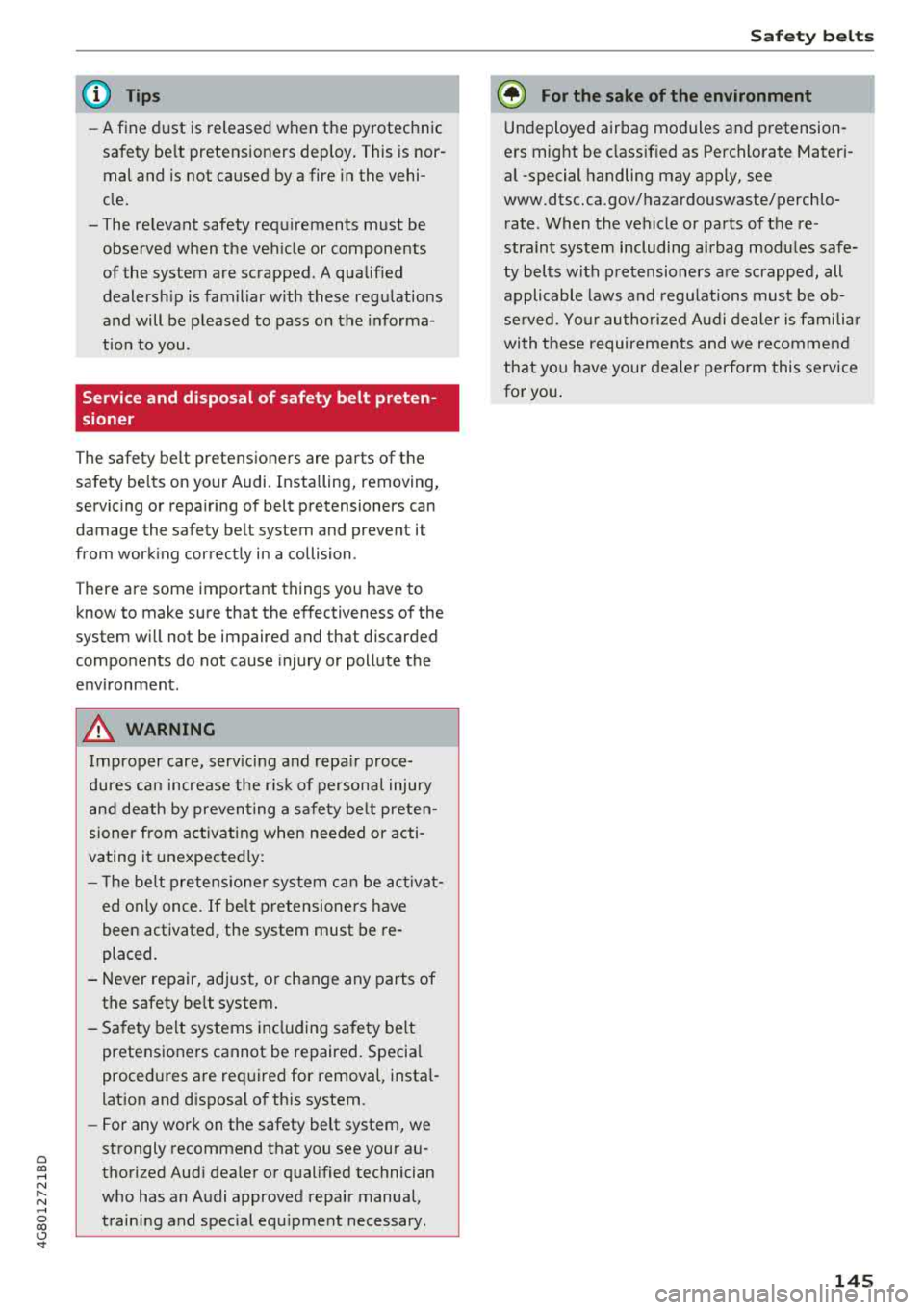
a co .... N
" N .... 0 00 \.J '
-A fine dust is released when the pyrotechnic
safety be lt pretens ioners deploy . This is nor
mal and is not caused by a fire in the vehi
cle.
- The re levant safety requirements must be
observed when the veh icle or components
of the system are scrapped. A qualif ied
dealersh ip is familiar w ith these regulations
and will be pleased to pass on the informa
tion to you.
Service and disposal of safety belt preten
sioner
The safety be lt pretensioners are parts of the
safety belts on your Audi. Installing, removing,
servicing or repa iring of belt pretensioners can
damage the safety belt system and prevent it
from work ing correctly in a collision .
There are some important things you have to know to make sure that the effectiveness of the
system w ill not be impaired and that discarded
components do not cause injury or pollute the
env ironment.
A WARNING
-
Improper care, serv icing and repa ir proce
dures can increase the r is k of personal injury
and death by preventing a safety be lt preten
sioner from activating when needed or acti
vating it unexpectedly:
- T he be lt pretensione r system can be act ivat
ed only once . If belt pretensione rs have
been activated, the system must be re
placed.
- Never repair, adjust, or change any parts of the safety be lt system .
- Safety belt systems including safety belt
pretensioners cannot be repaired. Specia l
procedures are required for removal, insta l
lation and disposal of this system.
- For any work on the safety belt system, we
strongly recommend that you see your au
thorized Aud i dea ler or qualified technician
who has an Audi approved repair manual,
train ing and spec ial equ ipment necessary .
Safety be lts
{® For the sa ke of the environment
Undeployed airbag modules and pretension
ers might be classif ied as Perchlorate Materi
al -special handling may apply, see
www.dtsc.ca.gov/hazardouswaste/perchlo rate . When the vehicle or parts of the re
straint system including airbag modules safe
ty belts with pretensioners are scrapped, all
applicable laws and regu lations must be ob
se rved. Your authorized Audi dealer is familiar
with these requirements and we recommend
that you have your dealer perform this service
for you .
145
Page 148 of 274
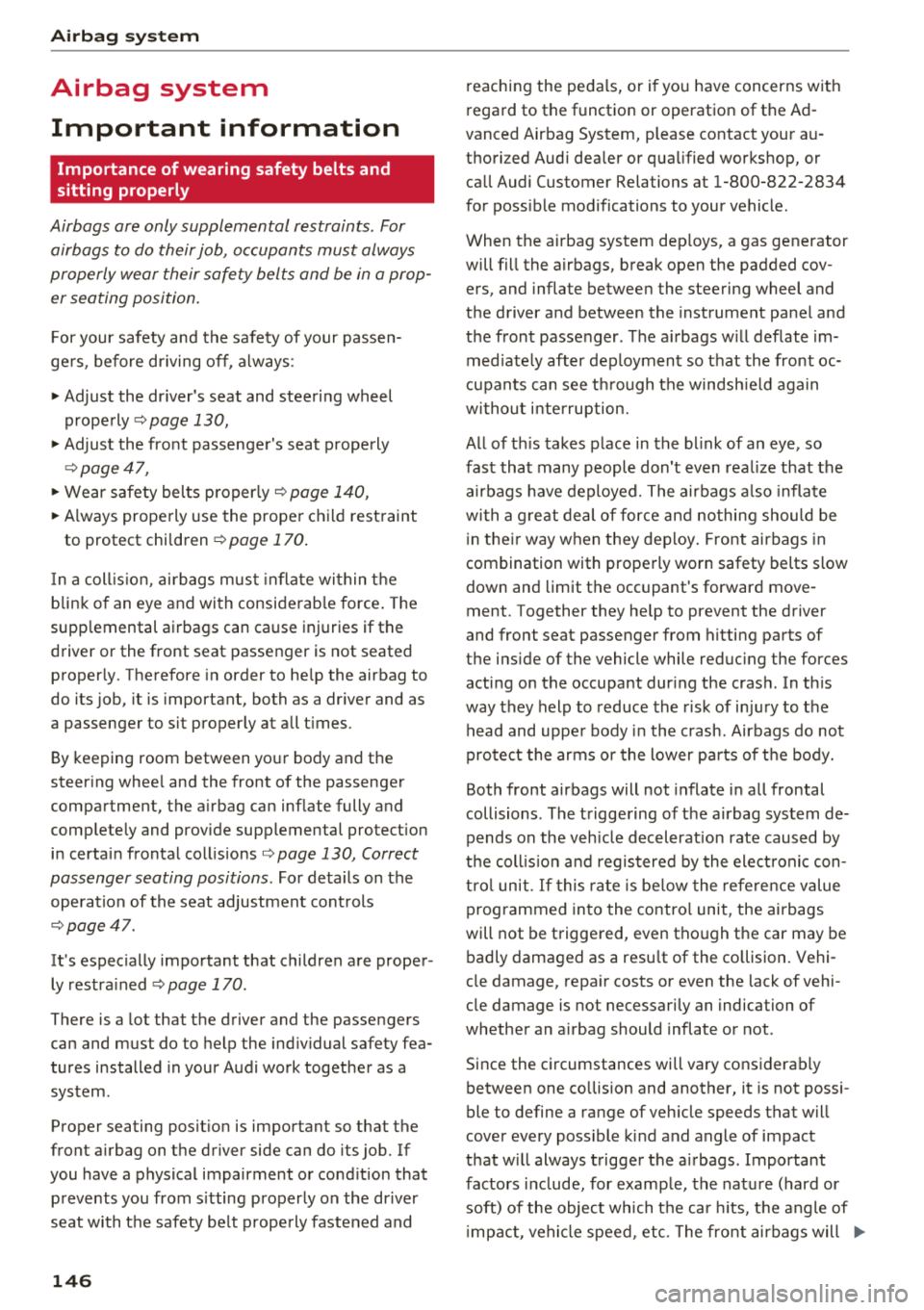
Airbag system
Airbag system
Important information
Importance of wearing safety belts and
sitting properly
Airbags are only supplemental restraints . For
airbags to do their job, occupants must always
properly wear their safety belts and be in a prop er seating position.
For your safety and the safety of your passen
gers, before driving off, always:
.,. Adjust the dr iver's seat and steering wheel
properly~ page 130,
.,. Adjust the front passenge r's seat properly
~page 47 ,
.,. Wear safety belts properly~ page 140,
.. Always properly use the proper child restraint
to protect chi ldren
~page 170 .
In a coll is ion, airbags must inflate within the
blink of an eye and with considerable force. The
supp lemental airbags can cause injuries if the
driver or the front seat passenger is not seated
properly. Therefore in order to he lp the airbag to
do its job, it is important, both as a dr iver and as
a passenger to sit properly at all t imes.
By keeping room between your body and the
steering whee l and the front of the passenger
compartment, the air bag can inflate fully and
completely and provide supplemental protect ion
in certain frontal
coll isions¢ page 130, Correct
passenger seating positions .
For details on the
operation of the seat adjustment controls
¢ page 47.
It's especially important that children are proper
ly restrained
¢ page 170.
There is a lot that the driver and the passengers
can and must do to help the ind iv idual safety fea
tures installed in your Audi work together as a
system.
Proper seating posit ion is important so that the
front airbag on the driver side can do its job. If
you have a physical impairment or cond ition that
prevents you from s itting properly on the driver
seat with the safety be lt properly fastened and
146
reaching the pedals, or if you have concerns with
regard to the function or operation of the Ad
vanced Airbag System, please contact your au
thorized Audi dea ler or qualified workshop, or
ca ll Audi Customer Relations at 1-800-822-2834
for poss ible modifications to your vehicle .
When the airbag system dep loys, a gas generator
will fill the airbags, break open the padded cov ers, and infla te between the steering wheel and
the driver and between the instrument panel and
the front passenger. The a irbags w ill deflate im
med iate ly after deployment so that the front oc
cupants can see through the windsh ield aga in
without interruption.
All of th is takes place in the blink of an eye, so
fast that many people don't even realize that the
a irbags have deployed. The airbags also inflate
with a great deal of force and nothing should be
in the ir way when they deploy. Front airbags in
combination with properly worn safety belts slow
down and limit the occupant's forward move
ment. Together they help to prevent the driver
and front seat passenger from hitting parts of
the ins ide of the vehicle while reduc ing the forces
acting on the occupant dur ing the crash . In th is
way they help to reduce the risk of injury to the
head and upper body in the crash . Airbags do not
protect the arms or the lower parts of the body.
Both front airbags will not inflate in all frontal
collisions. The triggering of t he a irbag system de
pends on the veh icle deceleration rate caused by
the collis ion and registered by the electronic con
trol unit. If this rate is be low the refe rence value
programmed into the control unit, the airbags
will not be triggered, even tho ugh t he car may be
badly damaged as a resu lt of the co llision . V ehi
cle damage, repair costs or even the lack of vehi
cle damage is not necessarily an indication of
whether an a irbag should inflate or not.
Since the circumstances wi ll vary considerab ly
between one co llision and another, it is not possi
ble to define a range of veh icle speeds that will
cover every poss ible kind and angle of impact
that w ill always trigger the airbags. Important
factors include, for example, the nature (hard or
soft) of the object which the ca r hits, the angle of
im pact, vehicle speed, etc. The front airbags will
..,.
Page 149 of 274
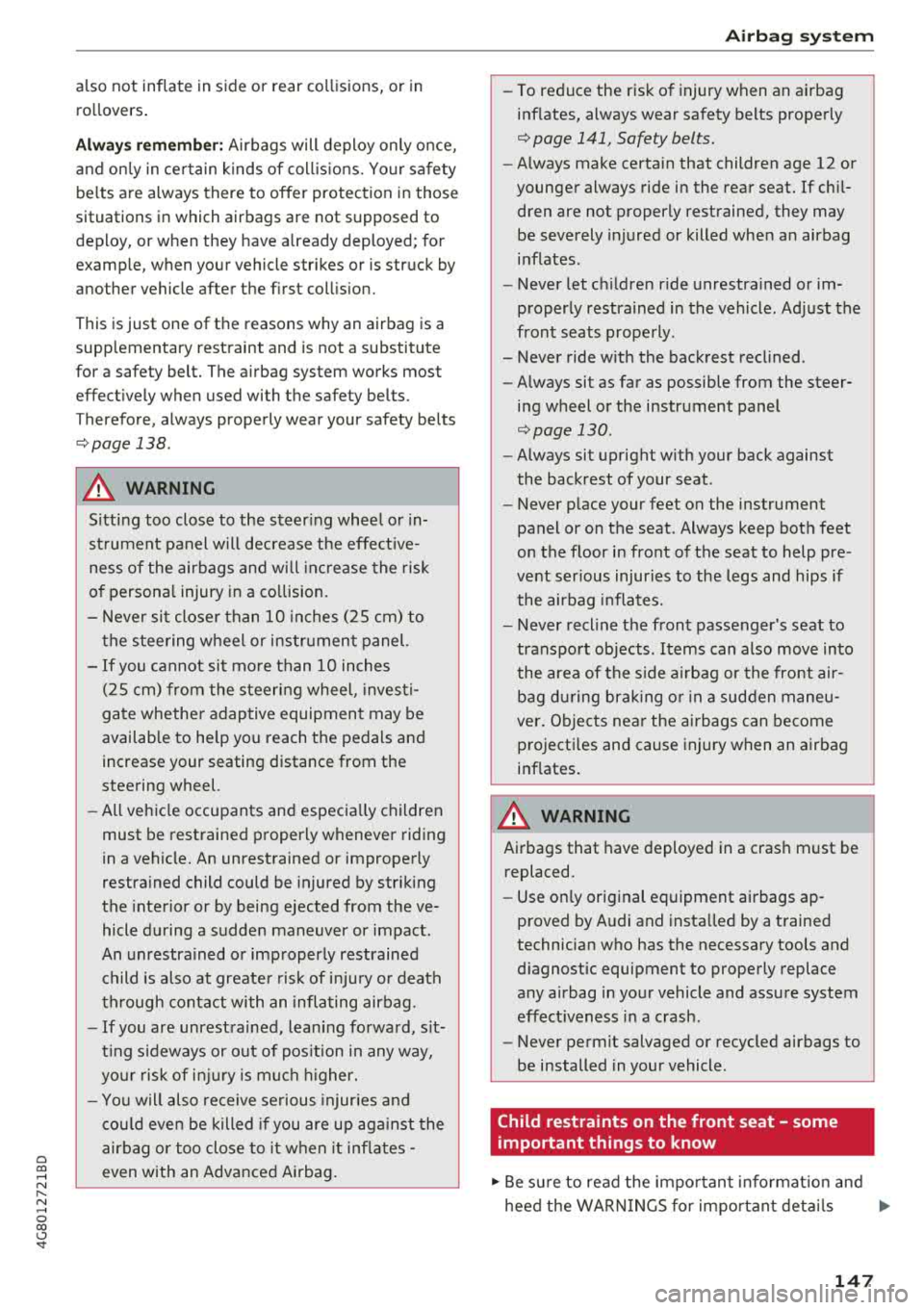
a co .... N
" N .... 0 00 \.J '
ro llovers .
Always re memb er: Airbags will deploy only o nce,
and on ly in ce rtain k inds of coll is ions. Yo ur safety
be lts are always there to offer protection in those
situations in which airbags are not supposed to
deploy, or when they have already deployed; for
examp le, when your vehicle str ikes or is struck by
another vehicle after the first coll is ion.
This is just one of the reasons why an airbag is a
supp lementary restraint and is not a substitute
for a safety belt. The airbag system works most
effect ively when used with the safety belts.
Therefore, always properly wear your safety belts
<=:> page 138 .
A WARNING
Sitting too close to the steer ing whee l o r i n
st rument panel w ill decrease the effe ct ive
ness of the airbags and will inc rease the risk
of persona l injury in a co llision.
- Never si t close r than 10 inches (25 cm) to
the stee ring w heel or instr ument panel.
- If you cannot sit mo re than 10 inches
(25 cm) from the s teeri ng wheel, invest i
gate whethe r adaptive equipment may be
availab le to he lp you reach the pedals and
increase your seating distance from the
steering wheel.
- All ve hicle occupants and especia lly children
must be restrained proper ly whenever riding
in a vehicle. An unrestrained or improperly
restra ined child could be injured by striking
the interior or by being ejected from the ve
hicle during a sudden maneuver or impact.
An unrestra ined o r imp roperly restrained
c hild is also at greate r risk of inju ry o r death
t h rough contact with an inflating airbag.
- If you are unrestrained, lean ing fo rwa rd, s it
ti ng s ideways or o ut of pos it ion in any way,
yo ur risk of i njury is m uch higher.
- Yo u will also receive se rious injur ies and
c ou ld eve n be killed if you are up aga inst the
air bag o r too close to it w hen it in flates -
even with an Advanced Airbag.
-
Airbag syste m
-To reduce the r is k of injury when an airbag
inf lates, always wear safety belts prope rly
<=:> page 141, Safety belts.
- Always make certain that children age 12 or
younge r always ride in the rear seat. If chil
dren are not properly restrained, they may be severely injured or killed when an airbag
i n flates.
- Never let c hildren r ide unrestra ined or im
properly restrained in the vehicle . Ad just the
front seats properly.
- Never ride w ith the backrest recl ined .
- Always sit as far as possible from the steer-
ing wheel or the instrument pane l
<=:> page 130.
-Always sit upright w ith your back against
the backrest of your seat .
- Never p lace your feet on the instrument
panel or on the seat. Always keep bot h feet
on the floor in front of t he seat to help pre
vent ser ious injur ies to the legs and hips if
the airbag inflates.
- Never recl ine t he fron t passenger's seat to
transpo rt objects . Items can also move into
the area of the s ide airbag or the front air
b ag d uring brak ing o r in a sudden ma neu
ve r. Obje cts near the a irbags can be come
p rojecti les and cause injury when an airbag
inf lates .
A WARNING ,..__ -
Airbags that have deployed in a cras h m ust be
replaced.
- Use on ly original eq uipment airbags ap
proved by A udi and insta lled by a trained
technician who has the necessary tools and
d iagnostic equipment to properly replace
any airbag in yo ur vehicle and assure system
effect iveness in a crash.
- Never permit salvaged or recycled airbags to
be installed in you r vehicle.
Child restraints on the front seat - some
important things to know
.. Be s ure to read the impo rtant info rmat io n and
heed the WARN INGS for important deta ils
147
Page 150 of 274
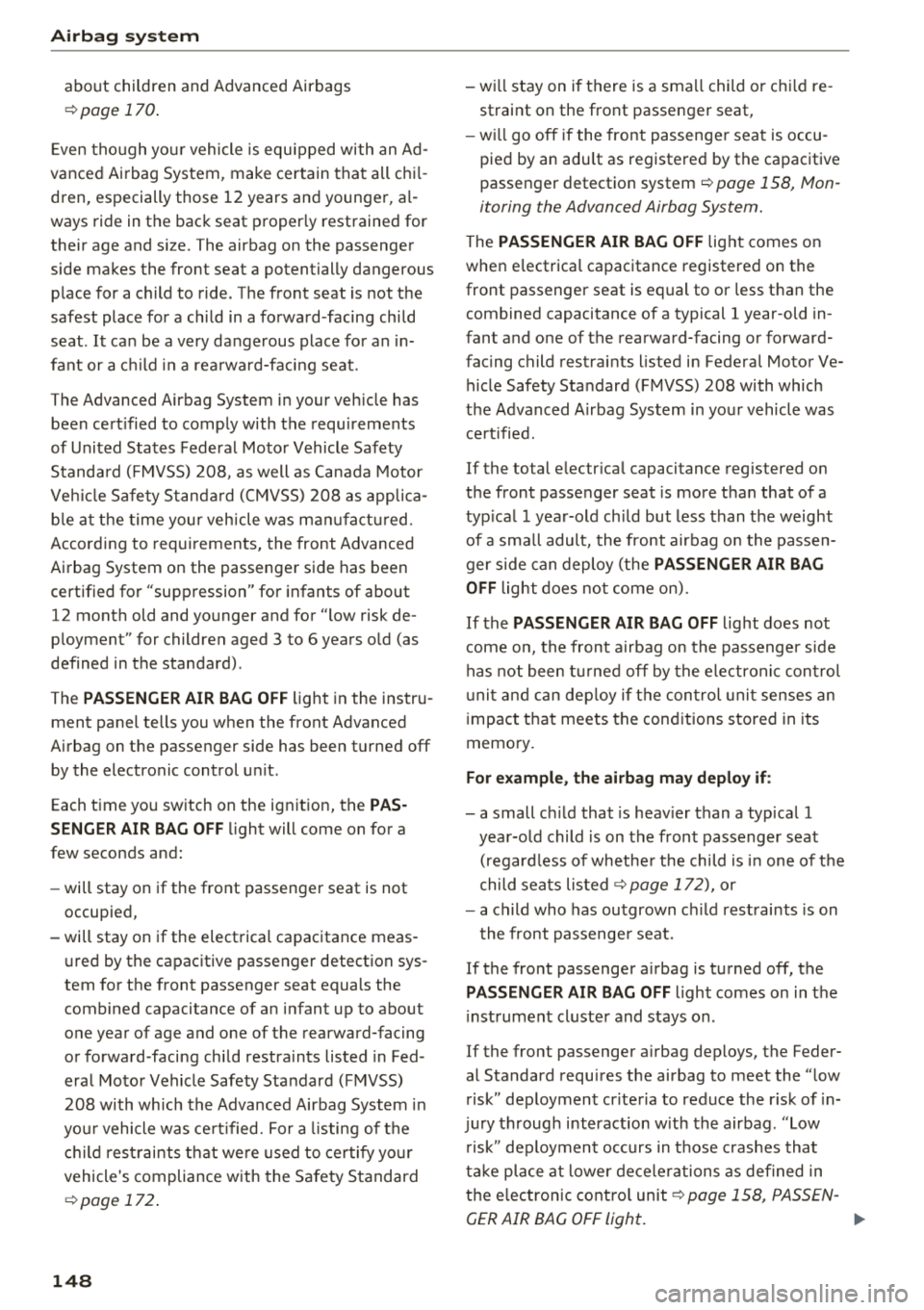
Airbag syste m
about children and Advanced Airbags
¢page 170 .
Even tho ugh yo ur vehicle is equ ipped with an Ad
vanced Ai rbag System, make certain that all chi l
dren, especially those 12 years and younger, al
ways ride in the back seat properly restrained for
their age and size. The airbag on the passenger
side makes the front seat a potentially dangerous
place for a child to ride. The front seat is not the
safest place for a child in a forward-facing child
seat . It ca n be a very dangerous place for an in
fant or a c hild in a rea rwa rd-fac ing seat.
The Advanced Airbag System in your veh icle has
been cert ified to comply with the requ irements
of United States Federal Moto r Vehicle Safety
Standard ( FMVSS) 208, as well as Canada Motor
Ve hicle Safety Standa rd (CMVSS) 208 as applica
b le at the time your veh icle was ma nufactu red.
Acco rding to requi rements, the front Advanced
Airbag System on the passenger side has been
certifi ed for "suppression" for infants of about
12 month old and younger and for "low risk de
p loyment" for children aged 3 to 6 years o ld (as
defined in the standard) .
Th e
PASSENGER AIR BAG O FF light in the instru
ment panel tells you when the front Advanced
Airbag on the passenger side has been turned off by the electronic control un it .
Each time yo u switch on the ignition, the
PAS·
S ENGER AIR BAG OFF
light will come on for a
few seconds and:
- will stay on if the front passenger seat is not
occupied,
- will stay on if the electrical capacitance meas
u red by the capacitive passenger detection sys
tem for the front passenger seat equals the combined capacitance of an infant up to about
one year of age and one of the rearward-facing
or forward-facing child restraints listed in Fed
eral Motor Vehicle Safety Standard (FMVSS)
208 with wh ich the Advanced Airbag System in
yo ur vehicle was ce rt ified. For a listing of the
c hi ld rest raints t hat we re used to ce rtify yo ur
vehicle 's compliance with the Safety Standard
¢ page 172 .
148
-w ill stay on if there is a sma ll child o r chil d re
straint on the front passenger seat,
- w ill go off if the front passenger seat is occu
pied by an adu lt as registered by the capacitive
passenger detection system ¢
page 158, Mon
itoring the Advanced Airbag System.
The PASSENGER AIR BAG OFF lig ht comes on
when e lectrica l capacitance registered on the
front passenger seat is equal to or less t han the
combined capacitance of a typical
1 year-old in
fant and one of the rearward-facing or forward
facing child restrai nts listed in Federa l Motor Ve
hicle Safety Standard (FMVSS) 208 with which
the Advanced A irbag System in yo ur vehicle was
ce rt ified.
If the to tal e lectr ica l capacitance registered o n
the front passenger seat is more than that of a
typ ical 1 yea r-old ch ild but less than the weight
of a sma ll adult, the front airbag on the passen
ger side can deploy (the
PASSENGER AIR BAG
OFF
light does no t come on).
If the
PASSENGER AIR BAG OFF light does not
come on, the front airbag on the passenger s ide
has not been turned off by the electroni c con trol
u nit a nd can dep loy if the con trol unit senses an
i mpact t hat meets the cond itions stored in its
memory.
For exampl e, the airbag ma y deplo y if:
- a small ch ild that is heav ier than a typ ical 1
year-old child is on the front passenger seat (regard less of whethe r the child is in one of t he
child seats listed
¢ page 172), or
- a child who has outgrown c hild rest raints is on
the front passenge r seat.
If the front passenger a irbag is turned off, the
PASSENGER AIR BAG OFF light comes on in the
i nst rument cluster and stays on .
If the front passenger a irbag deploys, the Feder
al Standard requires the airbag to meet the "low
risk" deployment cr iteria to reduce the r isk of in
j u ry th rough interact ion w ith the airbag .
"Low
risk " dep loyment oc curs in t hose crashes tha t
t a ke place at lowe r decele ra tions as defined in
t h e e lec tronic co ntro l unit
¢ page 158 , PASSEN-
GER AIR BAG OFF light.
..,_